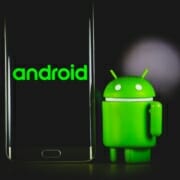5 Android App Development Myths, Debunked
Whether we like it or not, development myths surround the Android platform. In a way, the Android platform is a victim of its own success, given its vast popularity. As the world’s leading mobile operating system (OS), it has evolved rapidly over the past 14 years. And with so many changes and new features introduced regularly, Android app developers have their work cut out for them.
It’s also necessary for developers to create apps that work well across a wide range of devices from various manufacturers. And there’s a need to test on more devices and spend additional time fixing bugs and patching apps.
These hoops that Android App developers have to jump through have led to several myths. One of which is that it’s far harder to develop for Android than iOS. And while there’s some truth to this, few realize that Android app development has become easier with the introduction of Kotlin and the Jetpack libraries.
But there are many more Android app development myths that we need to discuss. Read on to learn more about these myths and why we’re about to debunk them!
Myth 1: Android App Development Is Highly Profitable
During Android’s early years, many developers came on board to capitalize on this exciting new platform. And many of these developers found success, and much hype ensued about the Android platform. So much hype, in fact, that software developers specializing in other fields decided to pursue mobile app development.
But as the platform matured and Google Play became inundated with an abundance of apps, Android app development became less profitable and far riskier. As of September 2022, the Google Play Store had over 2,6 million apps. But that’s significantly lower when the store peaked at 3,6 million apps in March 2018.
So what does that bit of information tell us? It reveals that the golden age of Android app development has long passed. Developers and publishers have learned that it no longer makes sense to push apps onto the store on a whim. And that’s because the most successful and sustainable apps solve a problem and are high quality.
Ultimately, the Google Play Store still remains viable for those developers willing to go the extra mile. But newcomer Android developers will unlikely strike it rich with their first few apps. While there’s been a decline in apps available in the store, it’s still heavily saturated. Thus, it’s best to avoid being blindsided by claims on the internet about Android’s vast earning potential.
SCHEDULE A CONSULTATION WITH AN APP DEVELOPMENT EXPERT TO GET A CUSTOMIZED QUOTE!
Myth 2: The Android App Development Environment Is Inferior To iOS
That’s completely false and may even be the other way around. Google has gone to great lengths to improve the Android app development experience, and they’ve largely succeeded. Android Studio and the accompanying App Tools truly empower developers to make some amazing apps.
And if we’re to make a quick comparison between Android Studio and Apple’s XCode, we often find Android Studio’s code editor and layout designer more useful for handling larger projects. Some developers even seem to prefer Android Studio overall, but that’s also a matter of preference.
The only major downside of Android Studio is that it consumes far more memory than it should. Furthermore, it’s often a chore to configure and deal with the Android Emulator Hypervisor Driver. And this can get rather complicated if you’re using a system with an AMD processor. But once the Android Emulator is up and running, it truly gives you a feel of how your app will run on a wide range of devices.
Myth 3: You Need To Own A Wide Variety Of Test Devices
Preferably, yes, but it’s not necessary to own many test devices. The hard truth is that you probably don’t have the resources to own a large number of devices. Moreover, it doesn’t make sense to keep a bunch of older devices with deteriorating lithium-ion batteries in your studio, as that’s a potential fire hazard.
Instead, you’ll rely on the Android Emulator to give you a broad picture of how your app will run on devices made by various manufacturers. But you’ll still need to test on actual hardware, so you’ll use all the Android smartphones and tablets your team owns. And you can take things a step further by running an invite-only beta program where users with different devices can test your app.
You’ll implement analytics in your app to collect device and performance data. And you may also run a survey where you’ll ask your users questions related to the performance and smooth running of your app. Thus, you’ll gain a clearer picture of your app’s performance on a wide variety of devices. You’re also able to pinpoint the Android versions, manufacturers, models, and configurations that impact the performance of your app long before its official launch.
USE OUR APP COST CALCULATOR TO ESTIMATE THE COST TO BUILD YOUR APP!
Myth 4: You Need An Engine Such As Unity To Make Android Mobile Games
While Unity is a great choice for cross-platform mobile app development, you do have other options. There’s Unreal Engine if you need to create high-fidelity 3D games and AR/VR experiences. Then, there’s GameMaker and Godot if you want to make addictive pick-up-and-play 2D games.
However, if your team has the necessary skills, you may forgo a game engine. And instead, use tools and libraries such as Google’s Android Game Development Kit (AGDK). The AGDK libraries consist of the Android Frame Pacing library, Android Performance Tuner, and C/C++ game libraries.
The latter libraries allow developers more comfortable with C or C++ instead of Kotlin or Java to create Android mobile games. And since many legacy games have been programmed in C and modern games have been programmed in C++, porting these to Android becomes a lot easier.
Myth 5: You Can Easily Release Your Android Apps On Windows 11
Microsoft surprised everyone when they announced that Android apps would make their way to Windows 11. But it’s also one of the biggest app development myths to think this is as straightforward as it sounds. And that’s because Windows 11 users need to access the Microsoft Store and then download and install the Amazon Appstore. They’ll also need to sign in to their Microsoft Account (if necessary) and Amazon account.
That’s a very inconvenient process to gain access to Android apps only available on the Amazon Appstore. From a developer’s standpoint, it’s additional work to put an Android app onto the Amazon Appstore if it’s already on Google Play. It’s necessary to comply with Amazon’s guidelines and implement the Appstore SDK. Also, Amazon only accepts Android apps and not iOS apps, which may disappoint developers that support both platforms.
And while it’s possible to sideload Android apps on Windows 11 with Windows Subsystem for Android (WSA), it’s a complicated process. Most non-technical users will likely struggle with this; thus, the Amazon Appstore will remain the more convenient option. However, it’s a straightforward process to run Android apps from the Google Play Store on Chromebooks.
Android App Development Myths And Misconceptions
The Android platform remains exciting while offering developers the opportunity to reach over 2.8 billion users. But the popularity and overall success of the platform has led to various app development myths and misconceptions. We’ve debunked several of these, but we expect many more to make the rounds. Contact NS804 today to learn how we’ll help you create phenomenal Android apps that will reach mythical heights!













Leave a Reply
Want to join the discussion?Feel free to contribute!